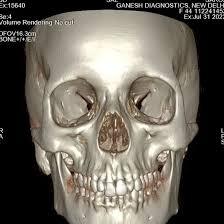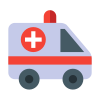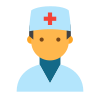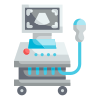Fill out form to enquire now
3D CT Head Scan
Medintu has collaborated with the best pathology laboratories that are NABL and NABH certified and follow ISO safety guidelines to provide the best 3D CT Head Scan at an affordable price for needy individuals. 3D CT Head Scan is an enhanced form of image production, which offers photorealistic quality images of the head and skull and other structures within the head. This noninvasive procedure employs CT technology to obtain slices of the coronal plane and then reconstruct them into 3D models with higher resolutions through which doctors can get a good perception of the structure from different angles. This CT Head Scan is the 3D version of the conventional 2D CT scans and gives a detailed and more realistic portrayal of the functions of the head. This makes it especially valuable for identifying fairly and safely many diseases, including glial and vascular tumours, trauma, infection and inflammation affecting the brain and spinal cord. Using detailed images of great resolution, 3D CT scans enable the physicians to solve problems that may not be seen in simple imaging, thus enhancing diagnosis, planning of treatment and follow-up. To schedule an appointment for a 3D CT Head Scan, simply contact Medintu or call our customer care at +919100907036 or +919100907622 for more details and queries.
How 3D CT Head Scan Works
A 3D CT head scan is a well-established, computer-based technique for making cross-sectional images of the head, ‘the brain, bones, blood vessels, and soft tissue. Here’s a general overview of how it works:
- X-ray Source and Detectors:
A CT scanner employs an X-ray source that rotates around the head and detectors that record multiple two-plane X-ray pictures.
The fluorescent sources emit radiation tracing a rotation around the head all the while and the detectors record the strength and density of the radiation passing through the tissues.
- Image Acquisition:
During data aquisition the X-ray source effectively ’scans’ thin slices of the head. They refer to layers of the head with regard to thickness of some particular slice.
These slices provide information on different density of tissues in the body as dense materials produce even more opaque regions than less dense ones in an X-ray.
- Computer Processing:
A computer then uses the data from these twodimensional x-ray images to reconstruct the three-dimensional image of head.
Special software analyzes the 2D picture of the organ in the form of slices and calculates the 3D model.
- 3D Visualization:
Once the 2D images are reconstructed into a 3D model, say a head, the doctor is in a position to view the head in three dimension. This allows for more accurate analysis and diagnosis of conditions such as:
Brain injuries
Tumors or growths
Structural abnormalities
Sinus problems, and more.
- Advantages of 3D Imaging:
Enhanced Detail: I prefer the results of a 3D CT scan to an X-ray because one can see soft tissues, bones and blood vessels in detail.
Non-invasive: The scan helps to collect some diagnostic data that can be received without operation or invasive manipulations.
Planning for Surgery: It helps to schedule surgeries or treatments easier since with the help of such imaging, physicians can see the head’s three-dimensional structure.
Indications for 3D CT Head Scan
A 3D CT head scan can be described as a diagnostic tool that is able to diagnose various medical conditions. This tool enables the imaging of internal organs such as the head with a more refined view. Here are the primary indications for , and an imaging test where a precise imaging of the head is crucial:
1. Trauma and Injury:
Injuries: For head trauma (e.g. from a fall or accident), a 3D CT scan of the head is often performed to check for fractures, contusions, or hematomas. It facilitates the identification of fractures, hemorrhagic foci of the brain, and edema.
CT scans are very beneficial in the diagnosis of any bleeding pattern inside the brain for interstitial haematoma, subdural haematoma, and intracerebral bleeding among others.
In case of a suspected concussion, a CT scan can exclude major trauma, including bleeding and structural damage within the brain.
- Brain disorders:
CT activities can Localize tumor cells both primary and distant through securing their size, site and the relationship surrounding structures.
A 3D CT scan can assist patients that come with stroke symptoms to identify any form of stroke that may be caused by a blood blockage (ischemic) or one caused by the spilling of blood ( Haemorrhagic).
- Neurovascular Issues:
CT Angiography (CTA FUSION): Because CTA fusion is utilized to visualize arteries and veins in the brain, it may help to diagnose bra in aneurysms or arteriovenous malformations (AVMs).
Arterial stenosis contributes to a well-defined vascular tree in MDCT and may provide voted imaging for assessing blood flow impairment and potential stroke factors.
- Congenital and Structural Abnormalities:
Congenital Brain Abnormalities: 3D Computer tomography is able to visualize the gross anatomical features of the brain and its surrounding elements including the actual structure of the brain folds, ventricles’ structure, and corpus callosum agenesis.
Skull Deformities: As for any other cranial deformities in children and adults, 3D Computerized tomography can also assess these early suture closures and craniosynostosis craniofacial conditions.
- Sinus and Skull Base Conditions:
Sinus Disease: As for computerized tomography scan procedures offering great advantages for the visualization of paranasal sinuses for their chronic sinusitis, sinus malignancies and polyps.
Skull Base Tumors: These tumors situated at the skull base may not be easy to visualize through radiograph and other primitive imaging modality. And to better evaluate this area, 3D SPECT CT helps to detail picturing this area and assist in the surgical concept.
Benefits of 3D CT Head Scan
In the context of making a diagnosis or in treatment planning, the use of 3D CT scans of the head offers a number of advantages. It provides incomparable detail in images of various structures, and in this case especially, a complete image of the brain, skull, blood vessels, and tissues surrounding them, which makes the healthcare professional’s decision-making process more precise. The 3D CT scans of the head brings the following major benefits:
- High Definition Imaging:
Thorough Inspection: 3D CT head scan is distinct from ordinary X-rays in that it helps to present cross-sectional views of the head featuring the brain, skull, blood vessels, as well as, soft tissues within its reach. This also presents an opportunity of improved visualization of complicated structures and their anomalies.
3D CTs enabled images showing bones and other complex structures; and soft tissues such as the brain and blood vessels with 3D CT imaging. This is useful in solving problems that might otherwise be impossible to address with standard rays for imaging.
- Lower Risk and Quick:
Least Risk-is a CT scan an invasive procedure? The answer is no hence doesn’t call for any forms of operation or cutting etc. The procedure involves lying down on a table while the machine spins and takes images, so no complications arise during the procedure making it safer for an individual.
Fast Outcomes: 3D CT scanning only takes a few minutes to accomplish and images are usually ready on the spot. This is especially useful in emergencies that require quick resolution, as in the case of
- Better Detection of Brain Conditions:
Accurate Diagnosis of Trauma: Though 3D CT scans are notably useful in identifying the following conditions in the brain: fractures, bleeding (hemorrhages), contusions, and brain swelling which may not be seen under lower resolution scans.
Early Detection of Tumors: Some of the applications of 3D CT include early identification of the tumor in the brain, including both the benign and the malignant varieties, as well as a determination of their size, shape, and position so that timely action may be initiated.
Stroke Assessment: CT is currently employed as one of the main diagnostic methods for ischemic (blockage) and hemorrhagic (bleeding) strokes, to inform subsequent management.
- Improved Surgical Planning:
Precise Planning for Neurosurgery: The Brain, Skull and Blood vessels 3-D model help the surgeons to plan out some of the difficult surgeries on the brain. They can determine when a tumor or lesion is present and to what extent, and they also can minimize or avoid damaging the structures during surgery.
Visualizing Complex Anatomy: The three-dimensional data may be used by surgeons “to navigate and keep track of” the anatomy of a brain, in order to assist them in moving through the target area with high accuracy in specific regions.
- Assessment of Blood Vessels:
3D CT Angiography: This specialized technique employed contrast agent to observe the blood vessels of the brain and identify disease like aneurysm, vascular abnormality, and obstruction. The 3D images are useful in performing a road map of the vessels, which might be useful during diagnosis and even surgery.
Vascular Abnormalities: It is also valuable to diagnose conditions that involve blood flow or anatomical abnormalities in arteries/veins of the brain, strokes or aneurysms for example.
- Test Type: 3D CT Head Scan
- Preparation:
- Wear a loose-fitting cloth
- Fasting not required
- Carry Your ID Proof
- Prescription is mandatory for patients with a doctor’s sign, stamp, with DMC/HMC number; as per PC-PNDT Act
- Reports Time: With in 3-4 hours
- Test Price: Rs.5000
How can I book an appointment for a 3D CT Head Scan through Medintu?
To schedule an appointment for a 3D CT Head Scan, simply contact Medintu or call our customer care at +919100907036 or +919100907622 for more details and queries.
What is a 3D CT head scan?
Health scan CT 3D head is a form of diagnostic imaging that generates 3D picture of head, brain, skull and blood vessels using X-ray enhanced by computer technology. This gives a clear view of the structures of the body and is normally used to diagnose various ailments in the body.
What makes a 3D CT head scan to differ from a normal CT scan?
A routine CT scans gives 2D axial sectional view of the body while a helical or 3D CT scans converts these sectional views into a 3D format. The model enhances perception, provides greater detail in visualisation and analysis of complex structures, which make it particularly convenient for surgical procedures as well as precise diagnosis.
Is a 3D CT head scan safe?
A 3D CT head scan does use ionizing radiation, albeit in small doses, but since the modality offers significant benefits in accurate diagnosis most of the time, then it is worth it if applied correctly. All the recent advancement in CT imaging and protocols has significantly minimized the amount of radiation that a patient receives. Most probably your doctor will take into account the probabilities for and against the scan.
Is the procedure painful?
No, a 3D CT head scan is not invasive and does not hurt at all. The procedure is done while you are lying down on a table and during the scan you may be required to keep still. However, some patients require a contrast agent (a dye) to be injected which may cause some discomfort at the point of injection but the actual scan does not produce pain.
How many minutes are utilised for a 3D CT head scan?
The scan usually only lasts a few minutes. The scanning itself and the prep normally takes about 15-30 minutes in total, depending on how involved the scan is and whether or not a form of contrast is needed.
Am I required to do a 3D CT head scan?
As a rule, special preparation is not required. But, if a contrast agent is to be introduced (to get better images), there may be instructions not to eat or drink several hours prior to the scan. That is why if you are taking any medication, you should disclose the information to your doctor.
What is the best approach to take before the scan; should I eat or drink before the scan?
If you are not getting a contrast agent, most often you will be allowed to eat and drink freely. In normal circumstances when a contrast agent will be used in the scanning, you will be told to have an empty stomach for several hours before the scanning process.
Why Choose Medintu for 3D CT Head Scan?
Medintu is an online medical consultant that provides home-based medical services not only in your area but also in most cities in India, including Hyderabad, Chennai, Mumbai, Kolkata, and more. We have collaborated with diagnostic centers that have the best machines and equipment to ensure you get accurate results. Medintu provides 24-hour customer service for booking the appointment of the services and guides you with instructions. Medintu also provides the best diagnostic centers at low prices. Once you receive your test results, you can easily book an appointment with our network of experienced doctors for consultation. To schedule an appointment for a 3D CT Head Scan, simply contact Medintu or call our customer care at +919100907036 or +919100907622 for more details and queries.





